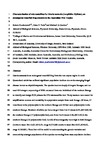Characterisation of microsatellites for Litoria nannotis (Amphibia : Hylidae), an endangered waterfall frog endemic to the Australian Wet Tropics
| dc.contributor.author | Puschendorf, Robert | |
| dc.contributor.author | Todd, EV | |
| dc.contributor.author | Gardner, MG | |
| dc.date.accessioned | 2017-03-23T09:12:22Z | |
| dc.date.available | 2017-03-23T09:12:22Z | |
| dc.date.issued | 2017-03-22 | |
| dc.identifier.issn | 0004-959X | |
| dc.identifier.issn | 1446-5698 | |
| dc.identifier.uri | http://hdl.handle.net/10026.1/8673 | |
| dc.description.abstract |
Litoria nannotis is an endangered waterfall frog from the wet tropics region in north Queensland that has suffered significant population declines due to the emerging fungal disease known as chytridiomycosis. The species has two deeply divergent lineages, and we used 454 shotgun sequencing of DNA extracted from one individual of the northern lineage to identify and design PCR primers for 576 microsatellite loci. Thirty markers were tested for amplification success and variability in a population sample from each lineage. Of these, 17 were found to be polymorphic in the northern lineage and 10 loci were polymorphic in the southern lineage. Numbers of alleles per locus ranged from 2 to 14 (mean = 6.47, s.d. = 4.02) for the northern lineage (17 polymorphic loci), and from 2 to 8 (mean = 5.40, s.d. = 2.55) in the southern lineage (10 polymorphic loci). Levels of heterozygosity were high in both lineages (northern meanHE = 0.63, s.d. = 0.21, range = 0.27–0.89; southern mean HE = 0.57, s.d. = 0.25, range = 0.18–0.81). These loci will be useful in understanding the genetic variation and connectivity amongst populations of this species recovering from mass population declines due to disease. | |
| dc.format.extent | 390-390 | |
| dc.language | en | |
| dc.language.iso | en | |
| dc.publisher | CSIRO Publishing | |
| dc.subject | 454 GSFLX | |
| dc.subject | population declines | |
| dc.subject | shotgun sequencing | |
| dc.title | Characterisation of microsatellites for Litoria nannotis (Amphibia : Hylidae), an endangered waterfall frog endemic to the Australian Wet Tropics | |
| dc.type | journal-article | |
| dc.type | Journal Article | |
| plymouth.author-url | https://www.webofscience.com/api/gateway?GWVersion=2&SrcApp=PARTNER_APP&SrcAuth=LinksAMR&KeyUT=WOS:000400824600003&DestLinkType=FullRecord&DestApp=ALL_WOS&UsrCustomerID=11bb513d99f797142bcfeffcc58ea008 | |
| plymouth.issue | 6 | |
| plymouth.volume | 64 | |
| plymouth.publication-status | Published | |
| plymouth.journal | Australian Journal of Zoology | |
| dc.identifier.doi | 10.1071/zo16072 | |
| plymouth.organisational-group | /Plymouth | |
| plymouth.organisational-group | /Plymouth/Faculty of Science and Engineering | |
| plymouth.organisational-group | /Plymouth/Faculty of Science and Engineering/School of Biological and Marine Sciences | |
| plymouth.organisational-group | /Plymouth/REF 2021 Researchers by UoA | |
| plymouth.organisational-group | /Plymouth/REF 2021 Researchers by UoA/UoA06 Agriculture, Veterinary and Food Science | |
| plymouth.organisational-group | /Plymouth/Users by role | |
| plymouth.organisational-group | /Plymouth/Users by role/Academics | |
| dcterms.dateAccepted | 2017-03-09 | |
| dc.identifier.eissn | 1446-5698 | |
| dc.rights.embargoperiod | Not known | |
| rioxxterms.funder | Australian Research Council | |
| rioxxterms.identifier.project | Environmental determinants of mass extinctions by emerging disease: why does chytridiomycosis exterminate frogs in rainforest but not in open forest? The emerging fungal disease known as chytridiomycosis is causing decline and extinctions of many species of frogs around the world; Australia is no exception | |
| rioxxterms.versionofrecord | 10.1071/zo16072 | |
| rioxxterms.licenseref.uri | http://www.rioxx.net/licenses/all-rights-reserved | |
| rioxxterms.licenseref.startdate | 2017-03-22 | |
| rioxxterms.type | Journal Article/Review | |
| plymouth.funder | Environmental determinants of mass extinctions by emerging disease: why does chytridiomycosis exterminate frogs in rainforest but not in open forest? The emerging fungal disease known as chytridiomycosis is causing decline and extinctions of many species of frogs around the world; Australia is no exception::Australian Research Council |


